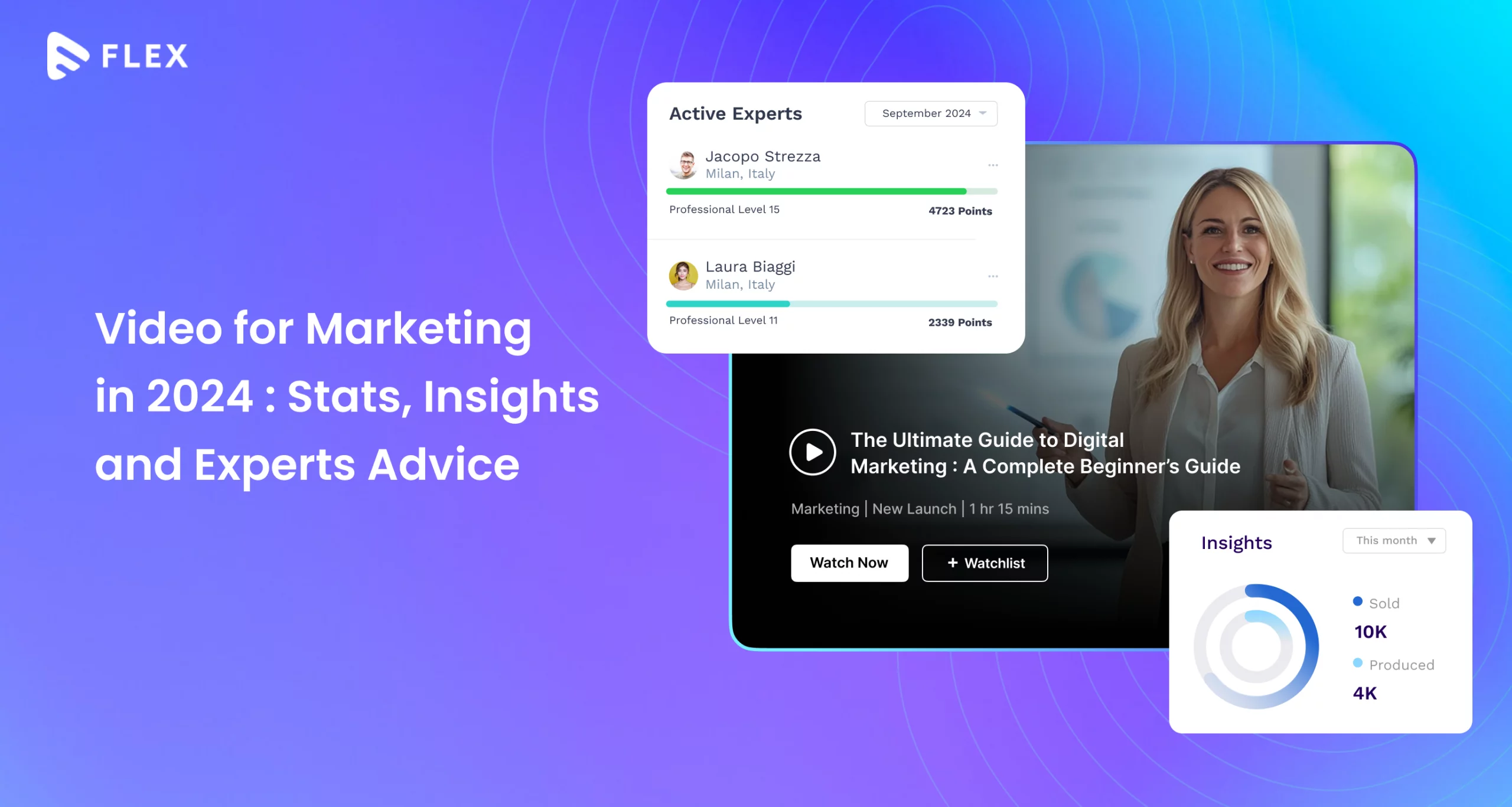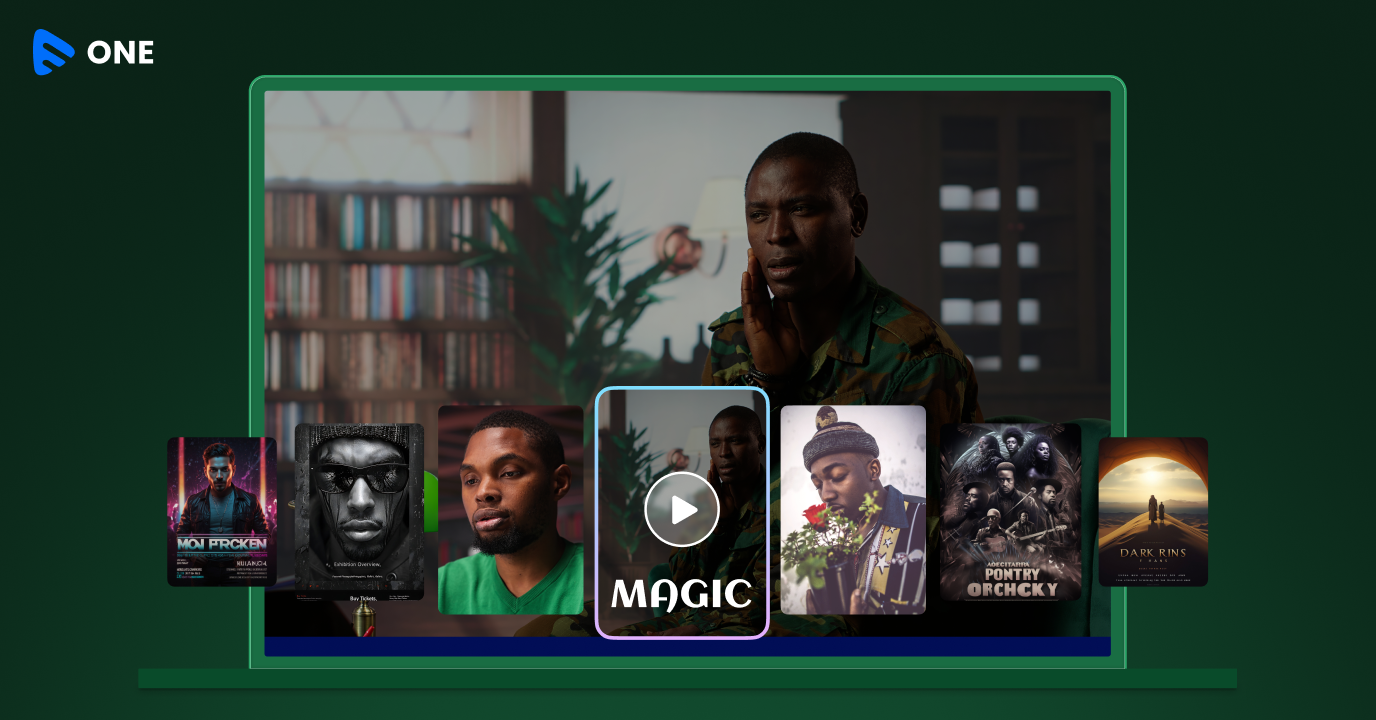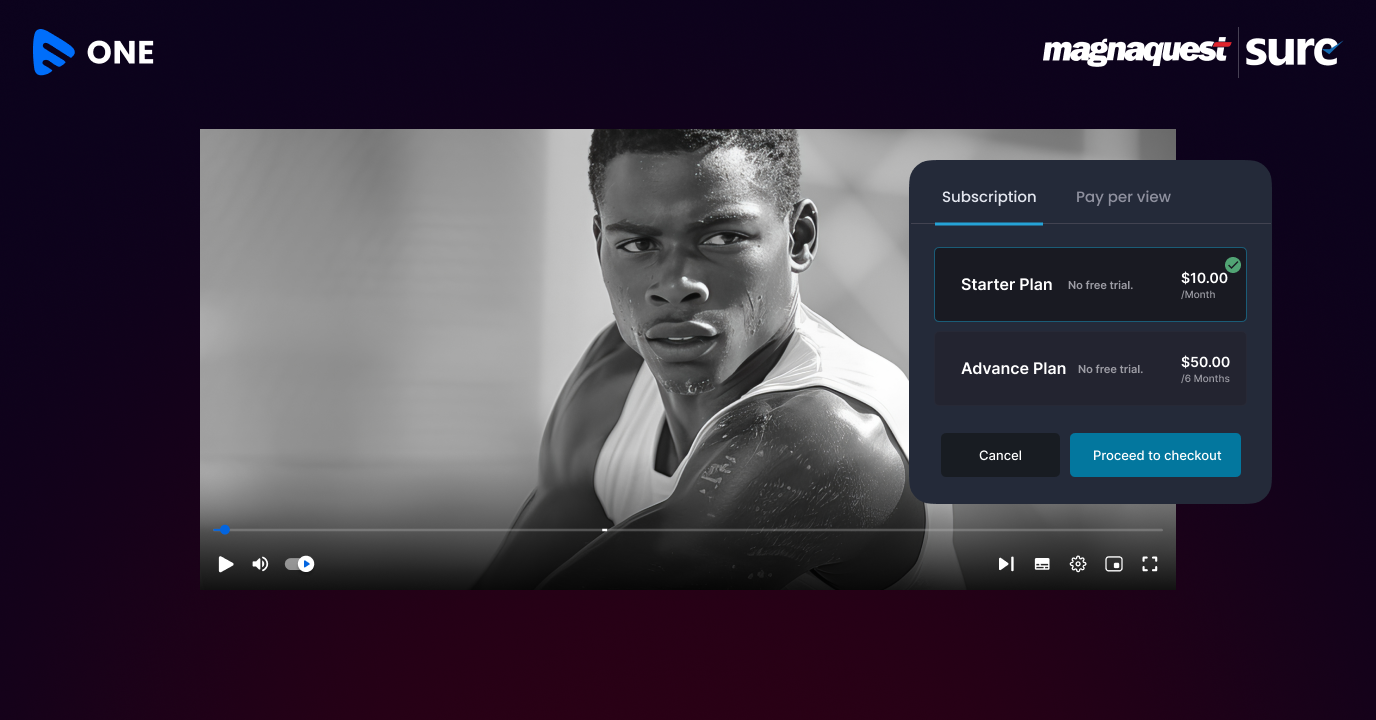Has it ever happened to you? – You are just casually scrolling through Instagram, YouTube, or even Facebook, and a video suddenly pops up. You get hooked on it and start watching it. Through the video, you come to know about an awesome new product or brand or even some new content streaming on a newly launched video streaming platform. You realize how much you need that product or service. So, you straight away go and purchase the product or subscribe to the service!
It has happened to all of us many times! And that precisely sums up the power of video for marketing in 2026. Your consumers love to watch videos. And when you pitch your product or service through videos, they instantly connect with it.
But just creating hook-worthy marketing videos is not enough. You need to manage, embed, and distribute them as efficiently as possible to gain the maximum results. And that is where video management platforms like Muvi Flex come handy.
In this blog, we will take you through the entire journey of video marketing, right from how it started, to how it is being used, and how your business can implement it successfully. So, let’s get started!
Looking for a good video management platform for your video marketing endeavors? Try Muvi Flex for FREE for 14 days.
Click Here to get started!
Video Marketing – How It Started?
“Video Marketing” is nothing new. Even the ads that we watched on television since our childhood are all videos for marketing. But the scenario changed completely after YouTube and social media entered.
YouTube came into existence in 2005. And smartphones became popular post 2010. Together, they made viewing and sharing videos all the more easier. Then came TikTok, and the euphoria of “short bite-sized videos” started. Later they became even more popular with Instagram reels.
But the real push to video marketing was given by the COVID pandemic. People were mostly stuck in homes. So they started watching videos for fun. This led to an increase in ad impressions, as ads were mostly inserted into free videos.
Also, since people were mostly shopping online, they would swiftly click on the ad to land on an e-commerce site and place an order for the product. This led to a direct increase in sales.
But even if we do not consider ad videos, we can still see a massive use of videos in marketing – yes, organic marketing. And that’s our core topic of discussion today.
How Is Video Used for Marketing in 2026?
Video marketing in 2026 is NOT only about ads! The use of videos in organic marketing is much larger. Businesses are releasing hundreds of videos on YouTube, Instagram, Facebook, TikTok, and even on their company websites. In addition, they are creating product demo videos which are being shared by their sales teams to potential customers.
Types of Videos for Effective Marketing
Businesses are using the following types of videos for marketing:
- Explainer videos: These videos clearly and concisely explain complex concepts or products. You can use live or animated explainer videos based on your choice.
- Tutorials: Step-by-step guides that can educate viewers and position your product or service as the best available option.
- Behind-the-scenes content: This type of video is mainly used for branding. They offer a glimpse into your company’s culture and can build trust and authenticity.
- Customer testimonials: Sharing positive feedback from satisfied customers can strengthen your brand’s reputation score. They can be shared over social media or can be embedded on your website.
- Video email marketing: Including videos in your emails can increase open rates and click-through rates.
- Video for landing pages: Creating dedicated landing page videos can improve conversions.
- Short-form videos: You can create short videos targeting specific features or use cases of your product and publish them on social media platforms like TikTok, Instagram Reels, and YouTube Shorts. They are considered as high attention-grabbing content.
- Live streaming: Live streaming allows you to interact with your customers in real time. It helps in building community and fostering engagement. It is a really good option for product launch.
- Video advertising: While not strictly organic, platforms like YouTube and Facebook offer targeted video advertising options that can complement organic content.
- Product demonstrations: Interactive product demos with VR/AR can provide virtual product experiences that can enhance customer engagement for example checking the dimensions of an RV carport before purchase.
Video Marketing Statistics and Insights
The importance of videos in marketing is proved by the statistics given below.
Engagement and Reach
- 90% of consumers watch videos to learn about a product or service.
- 82% of consumers cite video as the convincing factor in a purchase they have made.
- 88% of businesses say video has helped increase brand awareness.
- 87% of businesses say video marketing significantly increased lead generation.
- 69% of people prefer video over text when learning about a product or service.
ROI and Conversion
- 9 in 10 marketers claim video marketing has given them a good ROI.
- Videos on landing pages can boost conversion rates by an impressive 86%.
- 87% of businesses agree that video marketing gives them a positive ROI.
- 39% of video marketers report more ROI on short-form videos of 30-60 seconds.
- 85% of video marketers say that video content is more effective at gathering an audience online than other content.
Social Media and Platforms
- 82% of internet traffic across the world is set to come from video marketing in 2022.
- 78% of marketers say YouTube is the most effective video marketing channel.
- 71% of marketers say Facebook is the most effective video marketing channel.
- 81% of marketing professionals plan to include video as a cornerstone in their marketing strategy over the next decade.
- 46% of businesses use live videos on social media platforms to attract attention.
Audience Preferences and Behavior
- 89% of consumers are hungry for more video content from brands.
- 69% of people prefer video over text when learning about a product or service.
- 50% of online users search for product videos before making a purchase.
- 4 out of 5 consumers believe demo videos are incredibly helpful.
- Videos with a duration of 30-60 seconds are considered the most effective according to 39% of marketers.
Video Creation for Marketing in 2026
Creating videos for marketing in 2026 is easier than ever. The smartphones now come with professional-grade cameras. You can simply use your phone to shoot the videos, and then edit them easily in any free video editor. Paid tools like Adobe Premiere Pro and Final Cut Pro can be used to enhance videos with effects, color correction, and more.
And the consumers are in fact loving those raw phone-shot videos much more than those professionally curated high-definition videos nowadays. They feel that these phone-shot videos are much more authentic.
Also, the current video creation setup is seeing an extensive use of AI. Especially in places like explainer video production, branded video content creation, and the list goes on. AI is being used not only for video creation, but also for editing, video transcription, captioning, and audience analysis. AI is being used to automate tasks like trimming, cutting, and adding transitions, while newer AI video editing tools are already capable of creating complete marketing videos from simple text prompts. AI-generated voice overs are used for narration or product demonstrations.
Key Points To Consider While Creating Your Videos:
- Vertical orientation: Videos optimized for platforms like TikTok and Instagram Reels are typically shot in a vertical format.
- Music and sound effects: Engaging audio tracks and sound effects can enhance the viewing experience.
- Emotional connection: Videos should aim to evoke emotions in viewers.
- Clear narrative: A well-defined story or message can help viewers understand and remember your content.
- Captions and subtitles: They help ensure your videos are accessible to people with hearing impairments.
- Audio descriptions: They help visually impaired viewers understand the concept of your videos.
Video Distribution for Marketing in 2026
Once you have created the video, it’s now time to distribute it. And SEO experts nowadays suggest that you should adopt a multi-channel distribution strategy for your marketing videos.
By distributing videos on multiple platforms, e.g., YouTube, social media, websites, email marketing, etc., you can tap into diverse audiences with different preferences and behaviors. The more platforms you use, the more opportunities your videos have to be discovered and shared.
And it has a deeper SEO impact too. When your videos are embedded on other websites, you can acquire backlinks, which can boost your search engine rankings. You can even do SEO optimization for your videos. Optimizing them for search engines with relevant keywords and descriptions can help them appear in search results directly.
Key Distribution Channels For Marketing Videos:
1. YouTube
YouTube continues to be the most popular medium for distribution of marketing videos globally. According to Statista, YouTube had over 2.5 billion monthly active users in 2023. Hence, it can offer a huge audience base to businesses. YouTube videos can rank in search engine results too, making it a valuable SEO tool.
2. Social Media Platforms
Social media platforms like Facebook, Instagram, TikTok, and LinkedIn offer diverse audiences and features. And hence, they become the second most valued marketing video distribution channel after YouTube.
Videos on these platforms often have high engagement rates due to their short-form nature and algorithm-driven recommendations. Many social media platforms have built-in video editing and sharing tools.
3. Company Websites
Hosting videos on your website allows for more direct engagement with your audience. Also, videos can improve conversion rates on landing pages and product pages. And optimizing videos on your website can boost your search engine rankings too.
4. Email Marketing
Videos can be embedded in emails; for example, you can add them to your email signature banner to reach specific segments of your audience. Videos can increase open rates and click-through rates of emails. They can also drive conversions by providing valuable information or demonstrations.
5. Video-Sharing Platforms
Video sharing platforms like Vimeo, Twitch, Dailymotion, etc. cater to specific niches or audiences. They can foster communities around specific topics or interests.
6. Paid Advertising
Platforms like YouTube, Facebook, and Instagram offer targeted advertising options for video campaigns. Paid advertising allows you to track performance and measure ROI. It can be an effective way to quickly reach a large audience.
Video Asset Management in 2026
If creating and distributing your marketing videos is daunting, managing your video assets is even more critical. In this era of cyber threats and piracy, no digital asset is safe. So just posting your videos on multiple channels is not enough. You must keep a backup of it in a really secure ecosystem.
That is why experts suggest that you must have a secured video management system – a central platform where you can host, store, manage, distribute, and analyze the performance of your videos across multiple channels, all from a single dashboard.
You can take help of secure enterprise-grade video hosting and management platforms for this purpose. Muvi Flex is one such platform. Let’s take a closer look into it.
Key Features of Muvi Flex
Muvi Flex is a powerful video hosting and management platform that offers a range of features to help you grow your businesses faster, by delivering top-notch video and audio content to their audience. It comes with built-in CDN to help you distribute your videos to every corner of the globe.
Here are some of its key features:
- Video Bulk Upload: Easily upload multiple videos and audio files at once.
- Content Library: Organize and manage your content efficiently.
- Metadata Management: Add relevant information like titles, descriptions, tags, and more.
- Playlist Creation and Sharing: Create playlists to group related content and share them with your viewers via HLS output.
- Social Sharing: Share your content directly to multiple social media platforms.
- Embed to Website: Easily embed your videos to your websites and apps, and let your users enjoy adaptive bitrate streaming.
- Branding: Customize the video player of your website with your logo, colors, and branding elements.
- Multi-DRM: Protect your content from unauthorized access and distribution.
- Watermark: Add dynamic and forensic watermarks to your content to prevent piracy.
- Interactive Elements: Add interactive elements to the player like buttons, speed control, and CTA.
- Analytics: Track viewer behavior and engagement metrics.
- API Access: Integrate Muvi Flex with your existing systems and applications.
- Third-Party Integrations: Connect with popular platforms like social media, CRM, and payment gateways.

Top Video Marketing Strategies – Suggested by Experts
Producing videos is easy. However, gaining leads and sales from the videos is the real challenge. We asked our in-house experts for their advice for driving sales and conversions from videos. And here’s what they’re saying ?
Provide Value and Relevance
In an attempt to make your videos hook-worthy, don’t forget to add value and relevance. Remember, a hook will only grab viewership. But you can convert your customers to viewers only if your videos can offer something valuable to them.
It can be new information, a new product or service detail, a solution to their pain points, or anything specific that will remain in their mind for a long time. Ensure your content aligns with your target audience’s interests and needs.
Quality of Videos
We know that it’s a debatable topic today. Many surveys and data suggest that people are interacting more with the raw videos shot using mobile devices. But even then, the quality of the video matters. Adding a video watermark can help protect your content and brand while ensuring it doesn’t get misused by others.
Ask yourself – would you want to watch a video that’s hazy and the voice is not audible enough? No right? Similarly, your viewers won’t too.
You can definitely use mobile devices and simple microphones to record your videos. But make sure that the overall picture quality is good enough and your voice is clearly audible.
Optimize For Search Engine
Discoverability of your videos is as important as producing and distributing them. To ensure that, make sure to use relevant keywords in titles, descriptions, and tags.
Provide accurate and detailed metadata to help search engines and YouTube algorithms understand your content. If you are embedding them on your website, submit a video sitemap to search engines to improve discoverability.
Leverage Social Media
Creating and distributing the same video on all social media channels is never a good idea. In this way, people will follow you only on one platform and your multi-channel growth will face hindrance.
That is why you should create videos tailored to each social media platform’s audience and format. And posting them is not enough. You should keep responding to their comments, messages, and mentions to build stronger relationships.
Use Analytics Wisely
Analytics is an extremely powerful tool. If used wisely, it can revolutionize your entire video marketing strategy for good.
Firstly, use analytics tools to identify trends and areas for improvement. Where are your viewers located? What can be their specific pain points? Which devices are they using?
Once you track all the key trends, use your analysis to make data-driven decisions and refine your video marketing efforts.
How to Measure Your Video Marketing Success?
Measuring the success of your video marketing efforts is extremely crucial. It helps you understand what works and what doesn’t.
But what and how to measure? Let’s start with the key metrics.
Key Metrics to Track:
1. Viewership Metrics
- Views: Total number of times your video has been watched.
- Watch Time: The average length of time viewers spend watching your video.
- Click-Through Rate (CTR): The percentage of people who click on your video thumbnail or link.
2. Engagement Metrics
- Likes: The number of people who have liked your video.
- Comments: The number of comments left on your video.
- Shares: The number of times your video has been shared on social media.
- Full-Screen Views: The number of people who watched your video in full-screen mode.
3. Conversion Metrics:
- Increase in Website Traffic: The number of people who visit your website after watching your video.
- Leads Generated: The number of leads generated through your video marketing efforts.
- Sales: The number of sales attributed to your video marketing campaigns.
4. Audience Metrics:
- Demographics: The age, gender, and location of your viewers.
- Interests: The interests and preferences of your audience.
- Device Usage: The devices used by your audience to watch your videos e.g., mobile, desktop, etc.
Tools For Measurement
Now that you know what metrics to track, let’s take a look at the tools you can use to track them.
1. Muvi Flex Analytics Dashboard
If you are using Muvi Flex to manage your video assets, you can use its detailed analytics dashboard. You will be able to track almost all the key metrics from the analytics dashboard easily.
In addition to engagement and conversion, you can also track revenue analytics, in case you are inserting ads into your content. In fact, you can easily integrate it with third-party analytics tools like Google Analytics.
2. YouTube Analytics
If you are releasing videos on YouTube, YouTube Analytics will offer a comprehensive view of your videos’ performance, including views, watch time, audience demographics, and engagement metrics.
You can understand your viewers’ demographics, interests, and behaviors. Identify where your viewers are coming from e.g., search, suggested videos, or direct. You can also track the performance of your playlists.
Overall on channel level, you can track likes, comments, shares, and subscribers.
3. Facebook Insights
Similar to YouTube Analytics, Facebook Insights can also provide insights into the performance of your videos you post on Facebook. You can track likes, comments, shares, and clicks on your posts. Analyze the performance of your videos, including watch time, retention, and audience engagement. Track conversions from your Facebook page, such as website clicks or purchases.
3. Superads Creative Performance Analytics
While platforms like YouTube Analytics and Facebook Insights are helpful for tracking engagement and audience behavior, they often don’t explain why certain video ads perform better than others. This is where creative analytics tools come into play. Some solutions now use AI to analyze patterns across high-performing ads, such as tone, visuals, pacing, and messaging, helping marketers identify which creative elements consistently drive engagement. Superside’s AI-powered creative analytics tool, Superads, is one such example, offering teams the ability to learn from what already works across platforms like Meta and TikTok and apply those insights to future campaigns.
The Future of Video Marketing – 2026 and Beyond
The future of Video Marketing looks even brighter with new trends like AI gaining even more prominence. Video content will become more interactive, incorporating elements like polls, quizzes, and augmented reality to engage viewers.
Platforms will leverage AI and machine learning to deliver personalized video recommendations based on user preferences. The use of AI in editing, captioning, and voiceovers will increase.
More and more companies are expected to adopt the “Video First” marketing strategy. Hence, they will allocate a significant portion of their marketing budget to video content.
Also, businesses are expected to embrace short-form video formats more to reach younger audiences and increase engagement. Platforms like TikTok will continue to shape the landscape of short-form video content. Other TikTok alternatives, such as Instagram Reels and YouTube Shorts, will intensify their presence in the market.
Wrapping Up
This is the era of Video Marketing, and it is only going to increase in the coming years. Along with ads, organic video marketing is equally relevant and effective. And good video management platforms play a big role in making your video marketing efforts successful.
If you are looking for a secure and easy to use video management platform, Muvi Flex will prove to be the perfect choice. It comes with built-in CDN and multi-DRM security. You can publish your videos on multiple social media platforms and embed your videos to your websites too.
Try Muvi Flex yourself! Click here to start your 14-day free trial today!














Add your comment